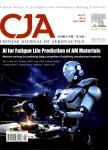Temperature effect on buckling properties of ultra-thin-walled lenticular collapsible composite tube subjected to axial compression
Temperature effect on buckling properties of ultra-thin-walled lenticular collapsible composite tube subjected to axial compression作者机构:School of Transportation Science and Engineering Beihang University
出 版 物:《Chinese Journal of Aeronautics》 (中国航空学报(英文版))
年 卷 期:2014年第27卷第5期
页 面:1312-1317页
核心收录:
学科分类:08[工学] 0805[工学-材料科学与工程(可授工学、理学学位)] 080502[工学-材料学]
基 金:supported by the National Natural Science Foundation of China (Nos. 51075019 and 51375033) Aeronautical Science Foundation (No. 20095251024) of China the Fundamental Research Funds for the Central Universities (No. YWF-13-T-RSC-121) of China
主 题:Axial compression Buckling Composite Finite element analysis Lenticular collapsible tube
摘 要:This paper seeks to outline the temperature effect on the buckling properties of ultra-thin-walled lenticular collapsible composite tube(LCCT) subjected to axial *** buckling tests of the LCCT specimens subjected to axial compression were carried out on INSTRON-500 N servo-hydraulic machine in dry state and at the temperatures of 25 C, 100 C and 80 C. The load–displacement curves and buckling initiation loads were measured and the buckling initiation mechanism was discussed from experimental observations. Experiments show that the buckling initiation load, on average, is only about 2.2% greater at the low temperature of 80 C than at the room temperature of 25 C due to the material hardening, demonstrating an insignificant increase in the buckling initiation load, whereas it is about 19.5% lower at the high temperature of 100 C than at the room temperature owing to the material softening, implying a significant decrease in the buckling initiation load. The failure mode of the LCCT in axial compression tests at three different temperatures can be reckoned to be characteristic of the buckling initiation and propagation around the central region until rupture. The finite element(FE) model is presented to simulate the buckling initiation mechanism based on the eigenvalue-based methodology. Good correlation between experimental and numerical results is achieved.



